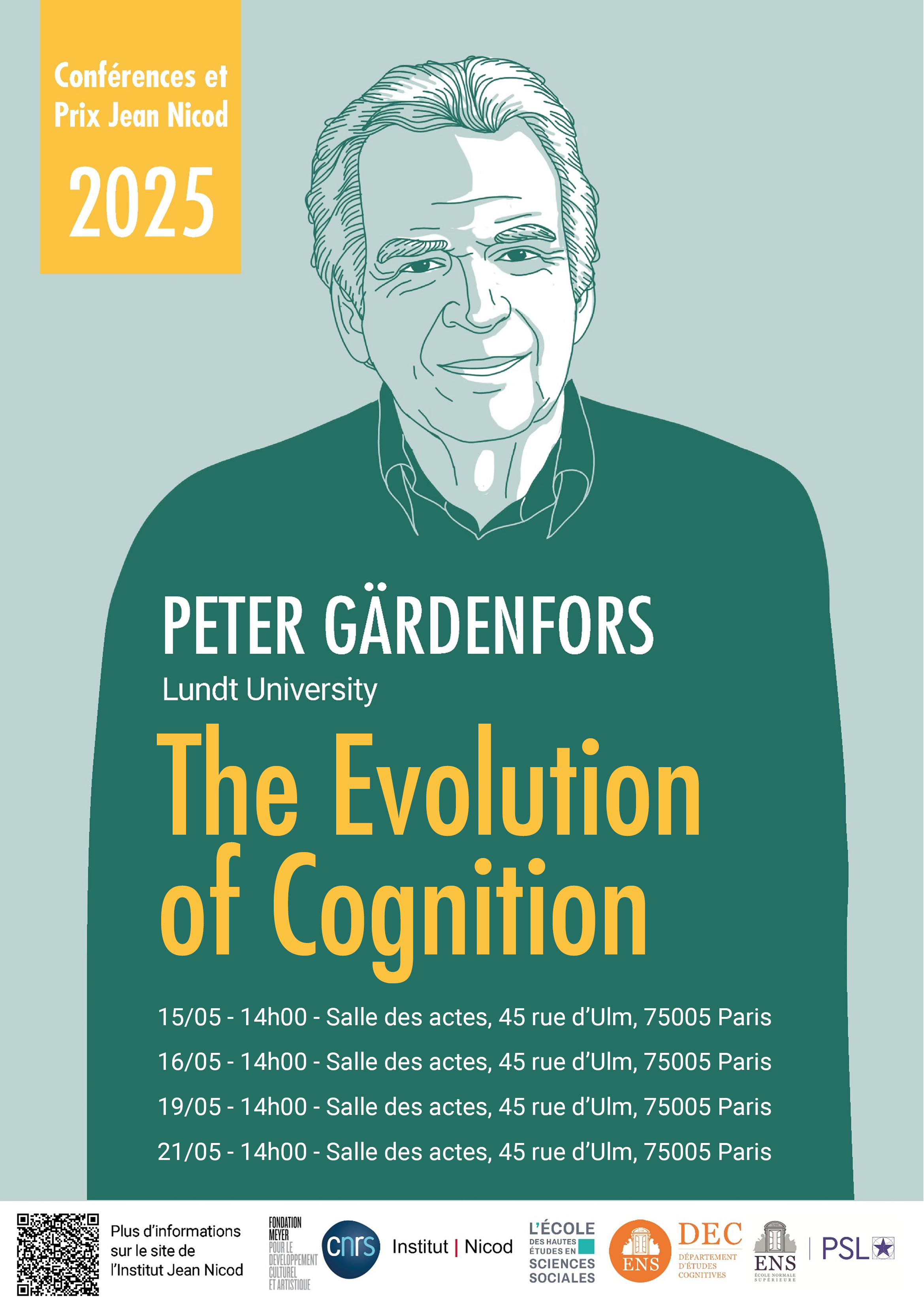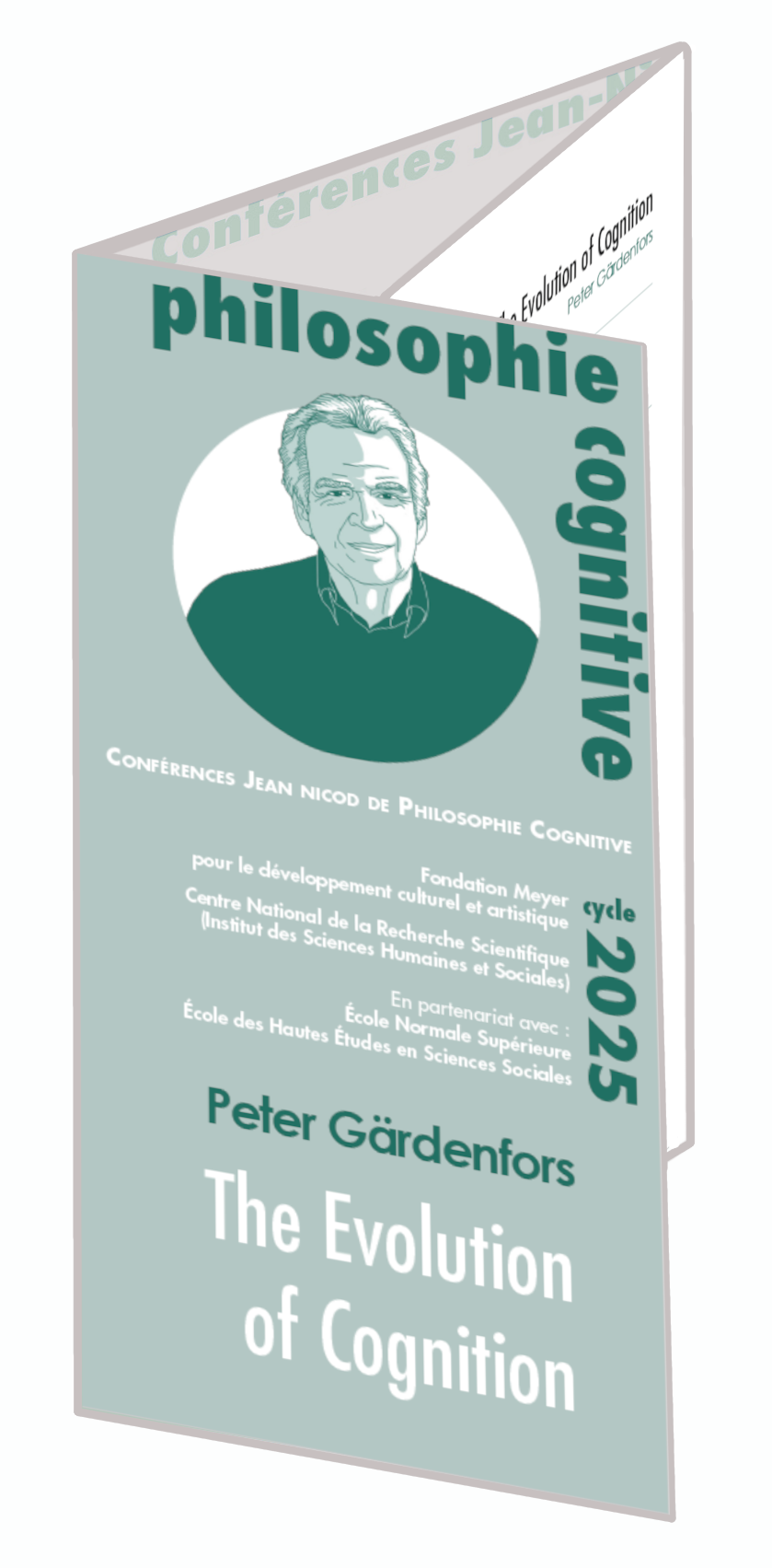Accueil > Séminaires/Colloques > Prix Jean Nicod > Conférences et Prix Jean-Nicod 2025 > Conférences et Prix Jean Nicod 2025
Conférences et Prix Jean Nicod 2025
Après un doctorat en philosophie théorique à l’Université de Lund, Peter Gärdenfors est devenu professeur associé en philosophie théorique puis professeur en sciences cognitives à l’Université de Lund. Il a également été professeur adjoint à l’Université de technologie de Sydney et, depuis 2019, il est associé principal de recherche au Palaeo-Research Institute de l’Université de Johannesburg. Il a beaucoup travaillé en philosophie des sciences, en théorie de la décision, ainsi que sur la révision des croyances et le raisonnement nonmonotone.
Ses principales recherches actuelles portent sur la formation de concepts à l’aide de modèles géométriques et topologiques d’espaces conceptuels, la sémantique cognitive, l’interaction homme-robot et l’évolution de la cognition humaine. Il est membre de l’Académie royale suédoise des lettres, de l’histoire et des antiquités, de l’Académie royale suédoise des sciences et de l’Académie royale suédoise des sciences de l’ingénieur. Il a également été membre du comité du prix Nobel d’économie.
The Evolution of Cognition
Causal cognition and early technology
Remise du Prix Jean Nicod et cocktail après la conférence
Jeudi 15 Mai - 2pm
Salle des Actes, 45 rue d’Ulm 75005 Paris
How to investigate the evolution of cognition ? This raises important methodological considerations, and in particular we need to consider the role of changes in ecology.
Consider the evolution of causal thinking. It can be decomposed into several stages. The first stages, involving bodily movements as causes, are common between human and non-human animals. By contrast, reasoning from effects to causes, such as inferring the presence of an animal from its track, is almost never found in non-human animals, whereas it is ubiquitous in humans. Reasoning about inanimate causes also seems very limited in non-human animals, while humans can exploit physical and chemical causes. A main thesis is that an increasing emphasis on technical engagement made some hominins capable of reasoning about the forces involved in causal processes. The causal thinking required for Stone Age hunting technologies such as throwing spears, bow hunting and the use of poisoned arrows is analyzed. The technologies serve as evidence for the evolutionary expansion of causal cognition.
—
Intersubjectivity and cooperation
Vendredi 16 Mai - 2pm
Salle des Actes, 45 rue d’Ulm 75005 Paris
Intersubjectivity (theory of mind) is not a unitary capacity. We can distinguish five domains of intersubjectivity : emotion, desire, attention, intention, and belief, which I will illustrate with examples in children and non-human animals. I will then focus on the different forms of cooperation, considering those present in non-human animals and those unique to humans, including cooperation about future goals, indirect reciprocity, teaching, and conventions. These forms are analyzed with respect to their cognitive and communicative prerequisites.
The capacity to plan for future needs, combined with more developed cooperative skills, opened up for cooperation towards future goals. Such cooperation requires complex intersubjectivity. Sharing intentions and beliefs about the future requires communication about what is not present in the current environment. Indirect reciprocity depends on reputation mechanisms. I will analyze the communicative requirements for such mechanisms.
—
The evolution of teaching
Lundi 19 Mai - 2pm
Salle des Actes, 45 rue d’Ulm 75005 Paris
During the evolution of Homo sapiens we also became Homo docens—the teaching animal. Teaching is not a unitary phenomenon. We can classify the different forms of teaching along the following lines : (i) evaluative feedback, (ii) drawing attention, (iii) demonstration and pantomime, (iv) communicating concepts, (v) explaining relations between concepts, and (vi) narrating. Only drawing attention and giving evaluative feedback is found in non-human animals. Humans draw attention by pointing, but this capacity is almost absent in other animals. A seemingly unique human capacity is teaching by demonstration, as illustrated by the Oldowan technology. Next stage is communicating concepts as a way of teaching causal connections, which is found in the Acheulean technology requires this form. Up to this stage, symbolic language is not required. Once a (proto-)language is in place, further forms of teaching, such as explaining relations between concepts and narrating, become available.
—
From pantomime to language
Mercredi 21 Mai - 2pm
Salle des Actes, 45 rue d’Ulm 75005 Paris
This lecture builds on the view that teaching in hominin societies is an important factor in the evolution of language (rather than language opening up for teaching). First, I will analyze differences between demonstration and pantomime. An important factor is that a pantomime can be detached, that is, it can refer to entities that are not present or to other moments of time. I shall then introduce a distinction between pantomime for teaching and for communication and analyze six factors– communicative sign function, degree of detachment, pragmatic form, represented action, perspective, and degree of pretense – which all suggest that pantomime for teaching is evolutionarily older. I will present a recent experiment that supports the distinction between the two types of pantomime. By conventionalization, pantomime for communication then gradually evolved into protolanguage involving a combination of gestures and vocalizations. After making some remarks on the evolution of grammar and its functions, I will defend a fundamental thesis : sentences typically express events.
> REGISTRATION <

Bibliographic selection
- Alchourrón, C.E., Gärdenfors P. and Makinson, D. (1985) : On the logic of theory change : Partial meet contraction and revision functions, Journal of Symbolic Logic 50, pp. 510-530.
- Gärdenfors P. . Knowledge in Flux : Modeling the Dynamics of Epistemic States, MIT Press, 1988.
- Gärdenfors P. Conceptual Spaces : The Geometry of Thought. MIT Press, 2000.
- Gärdenfors P. How Homo Became Sapiens : On the Evolution of Thinking, Oxford University Press, 2003.
- Gärdenfors, P. (2004). Cooperation and the evolution of symbolic communication. in The Evolution of Communication Systems, ed. by K. Oller and U. Griebel, MIT Press, 2004, pp. 237-256.
- Gärdenfors P. The Dynamics of Thought, Springer Verlag, 2005.
- Gärdenfors P. Geometry of Meaning : Semantics Based on Conceptual Spaces, MIT Press, 2014.
- Gärdenfors, P. and Högberg, A. (2017) The archaeology of teaching and the evolution of Homo docens, Current Anthropology 58(2), 188-208.
- Bellmund, J., Gärdenfors, P., Moser, E. and Doeller, C. /2018) : Navigating cognition : Spatial codes for human thinking, Science 362, 654, November 9.
- Gärdenfors, P. and Lombard, M. /2018) : Causal cognition, force dynamics and early hunting technologies, Frontiers in Psychology, February 12, 2018.





